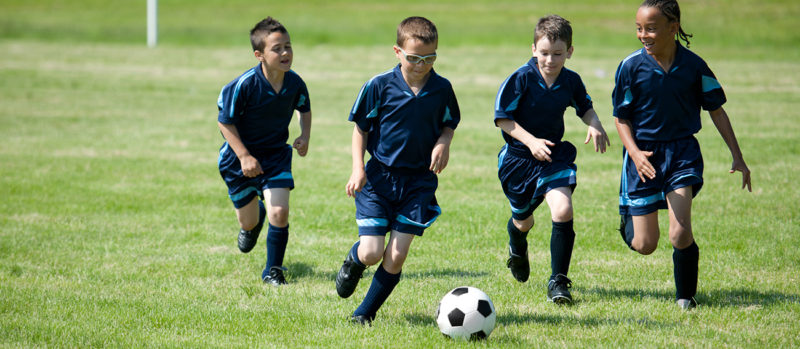The bulk of eye injuries in the United States happen to children. About 24% of those injuries take place during sports and recreational activities. The good news is that the vast majority of them can be prevented. In fact, the American Academy of Pediatrics recommends that all children playing organized sports wear eye protection.
Here’s what parents need to know about eye injuries in kids:
1. The type of sports
Essentially, eye injuries can occur in any sport. They can be from contact with another person or piece of equipment, falls, or a projectile or ball. According to the National Institute of Health (NIH), baseball is the leading cause of sports-related eye injuries in kids under 14. Basketball is the leading cause in those ages 15-24. Racquetball and hockey are also considered high risk sports for eye injuries.
2. The types of eye injuries
The NIH states that every 13 minutes an eye injury is treated in an emergency room in the U.S. The most common sports related eye injuries that occur are:
- Corneal and conjunctival abrasions. These can occur when the surface of the eye (cornea or conjunctiva) is scratched. This can cause pain, redness, and light sensitivity. For example, during basketball a child will reach for the ball and accidentally scratch her opponent’s eye.
- Traumatic hyphema. This can happen when there is a direct blow to the eye. The force pushes the eye inwards and can cause an injury to the iris (colored part of the eye). Tiny vessels can shear, and blood can enter the anterior chamber (space between the iris and the cornea). This often occurs along with inflammation. Hyphemas can lead to glaucoma and other complications even years later. Gun projectiles, such as Nerf guns, are often involved in this type of injury in kids.
- Orbital fracture. This involves a fracture of any of the bones around the eye, including the cheekbone. These injuries can impact the eye muscles as well as vision.
- Retinal Detachment. An injury to the head or eye can cause a tear in the retina (the layer of tissue in the back of the eye responsible for vision). People who are very near-sighted (myopic) may be more prone to these. Symptoms include vision loss, a shade or “curtain” over the vision, flashing lights, and floaters in the vision. Retinal tears and detachments can lead to permanent vision loss, especially if not treated quickly.
- Concussion. When this occurs, visual functioning can be affected even if the eyes were not involved in the initial accident. Blurry vision, double vision, dizziness, and light sensitivity lasting after the initial recovery period, are all symptoms that should be examined by an eye care provider.
3. The most typical ages
Children are most likely to injure their eyes during sports between the ages of 10-17 years old. Big changes in both ability and intensity happen during this age span, which may contribute to the frequency. Basically, kids can throw and kick much harder. Interestingly, 10-year-old boys endure more traumatic hyphemas compared to any other age group.
4. The precautions parents can take
The good news is that wearing helmets and sports goggles, or rec specs, can prevent the vast majority of sports eye injuries. Regular glasses do not provide adequate protection, especially on the sides. Wear lenses made of polycarbonate or other impact resistant material. This website offers free sport goggles and helmets with face masks to kids in Ohio who financially qualify. You can also visit this website to see the recommended eye protection for each specific sport.
5. The symptoms to be aware of
With eye injuries, parents often wonder if their child’s symptoms necessitate a visit to the emergency room versus a call to their pediatrician or ophthalmologist. Each situation is a little bit different. However, I would say that in general, it is important to consider the severity of the injury when making this decision.
If there is direct impact to an eye leading to the eye being swollen, bruised, and painful, especially if it occurs with a headache, vomiting/nausea, and other signs of a concussion (with or without loss of consciousness), go to the emergency room. If your child’s eye has been injured and it is painful but there is no loss of consciousness, no headache, no nausea or vomiting, and no other injury, you should still have it examined, but are probably safe to contact your optometrist or ophthalmologist.
When in doubt, seek immediate medical care from an emergency room. Parents can also always contact their child’s main primary care doctor for advice on which route to take.
For more information about our division of Ophthalmology, please call 513-636-4751 or fill out an online form for more information.





